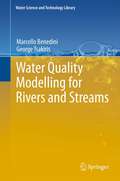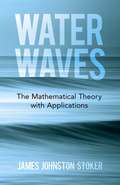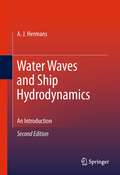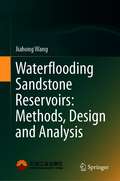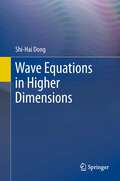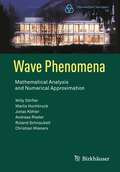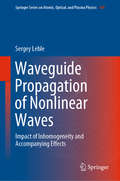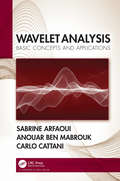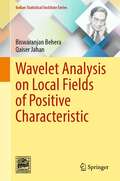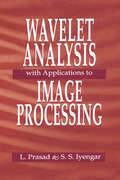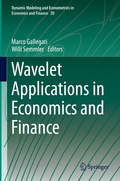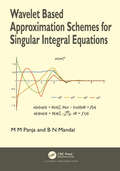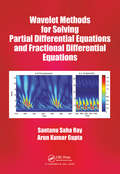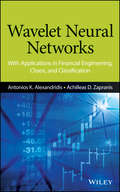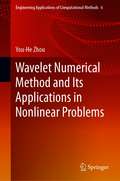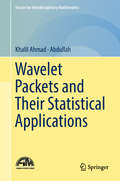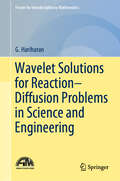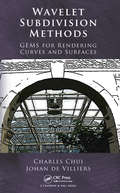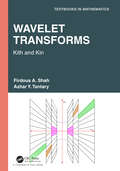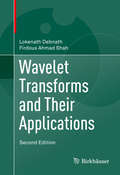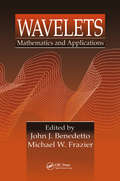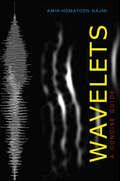- Table View
- List View
Water Histories and Spatial Archaeology
by Michael J. HarrowerThis book offers a new interpretation of the spatial-political-environmental dynamics of water and irrigation in long-term histories of arid regions. It compares ancient Southwest Arabia (3500 BC–AD 600) with the American West (2000 BC–AD 1950) in global context to illustrate similarities and differences among environmental, cultural, political, and religious dynamics of water. It combines archaeological exploration and field studies of farming in Yemen with social theory and spatial technologies, including satellite imagery, Global Positioning System (GPS), and Geographic Information Systems (GIS) mapping. In both ancient Yemen and the American West, agricultural production focused not where rain-fed agriculture was possible, but in hyper-arid areas where massive state-constructed irrigation schemes politically and ideologically validated state sovereignty. While shaped by profound differences and contingencies, ancient Yemen and the American West are mutually informative in clarifying human geographies of water that are important to understandings of America, Arabia, and contemporary conflicts between civilizations deemed East and West.
Water Quality Modelling for Rivers and Streams
by George Tsakiris Marcello BenediniThe main objective of the Water Framework Directive in the European countries is to achieve a "good status" of all the water bodies, in the integrated management of river basins. In order to assess the impact of improvement measures, water quality models are necessary. During the previous decades the progress in computer technology and computational methods has supported the development of advanced mathematical models for pollutant transport in rivers and streams. This book is intended to provide the fundamental knowledge needed for a deeper understanding of these models and the development of new ones, which will fulfil future quality requirements in water resources management. This book focuses on the fundamentals of computational techniques required in water quality modelling. Advection, dispersion and concentrated sources or sinks of contaminants lead to the formulation of the fundamental differential equation of pollutant transport. Its integration, according to appropriate initial and boundary conditions and with the knowledge of the velocity field, allows for pollutant behaviour to be assessed in the entire water body. An analytical integration is convenient only in one-dimensional approach with considerable simplification. Integration in the numerical field is useful for taking into account particular aspects of water body and pollutants. To ensure their reliability, the models require accurate calibration and validation, based on proper data, taken from direct measurements. In addition, sensitivity and uncertainty analysis are also of utmost importance. All the above items are discussed in detail in the 21 chapters of the book, which is written in a didactic form for professionals and students.
Water Waves: The Mathematical Theory With Applications (Dover Books on Physics)
by James Johnston StokerFirst published in 1957, this is a classic monograph in the area of applied mathematics. It offers a connected account of the mathematical theory of wave motion in a liquid with a free surface and subjected to gravitational and other forces, together with applications to a wide variety of concrete physical problems. A never-surpassed text, it remains of permanent value to a wide range of scientists and engineers concerned with problems in fluid mechanics.The four-part treatment begins with a presentation of the derivation of the basic hydrodynamic theory for non-viscous incompressible fluids and a description of the two principal approximate theories that form the basis for the rest of the book. The second section centers on the approximate theory that results from small-amplitude wave motions. A consideration of problems involving waves in shallow water follows, and the text concludes with a selection of problems solved in terms of the exact theory. Despite the diversity of its topics, this text offers a unified, readable, and largely self-contained treatment.
Water Waves and Ship Hydrodynamics: An Introduction
by A. J. HermansIn this book an introduction is given to aspects of water waves that play a role in ship hydrodynamics and offshore engineering. At first the equations and linearized boundary conditions are derived describing the non-viscous free surface water waves, with special attention to the combination of steady and non-steady flow fields. Then some simple kinds of free wave solutions are derived, such as plane waves and cylindrical waves. For several situations, steady and unsteady, the source singularity function is derived. These functions play a role in numerical codes used to describe the motion of ships and offshore structures. These codes are mostly based on a boundary integral formulation; therefore we give an introduction to these methods. It is shown how first order ship motions can be determined. In offshore engineering the second order wave drift motions play an important role. An introduction to this phenomenon is given and the effects which have to be taken into account are explained by means of a simple example where we can determine nearly all the aspects analytically. An interesting example that is worked out is the motion of very large floating flexible platforms with finite draft. Finally an introduction to the theory of shallow water non-linear dispersive waves is presented, and shallow water ship hydrodynamics, that plays a role in coastal areas and channels is treated. Here attention is paid to the interaction between passing ships in restricted water. In the appendix a short introduction to some of the mathematical tools is given.
Waterflooding Sandstone Reservoirs: Methods, Design and Analysis
by Jiahong WangThis book focuses on oilfield performance analysis and development adjustment by integrating geology, applied mathematics, and other relevant theories. Based on the abundant and detailed field test and production data from Daqing and Tarim, two major oilfields in China, the regularities, characteristics, design, and adjustment of waterflooding development of sandstone reservoirs throughout the life cycle are described. Field development theories and practices are organically combined in this book, which, embracing comprehensive, systematic, and pragmatic contents, is conducive to development technicians to quickly grasp the characteristics of waterflooding and prepare adjustment plans. It is also useful as a textbook in petroleum colleges and short training courses.
Wave Equations in Higher Dimensions
by Shi-Hai DongHigher dimensional theories have attracted much attention because they make it possible to reduce much of physics in a concise, elegant fashion that unifies the two great theories of the 20th century: Quantum Theory and Relativity. This book provides an elementary description of quantum wave equations in higher dimensions at an advanced level so as to put all current mathematical and physical concepts and techniques at the reader's disposal. A comprehensive description of quantum wave equations in higher dimensions and their broad range of applications in quantum mechanics is provided, which complements the traditional coverage found in the existing quantum mechanics textbooks and gives scientists a fresh outlook on quantum systems in all branches of physics. In Parts I and II the basic properties of the SO(n) group are reviewed and basic theories and techniques related to wave equations in higher dimensions are introduced. Parts III and IV cover important quantum systems in the framework of non-relativistic and relativistic quantum mechanics in terms of the theories presented in Part II. In particular, the Levinson theorem and the generalized hypervirial theorem in higher dimensions, the Schrödinger equation with position-dependent mass and the Kaluza-Klein theory in higher dimensions are investigated. In this context, the dependence of the energy levels on the dimension is shown. Finally, Part V contains conclusions, outlooks and an extensive bibliography.
Wave Phenomena: Mathematical Analysis and Numerical Approximation (Oberwolfach Seminars #49)
by Willy Dörfler Marlis Hochbruck Jonas Köhler Andreas Rieder Roland Schnaubelt Christian WienersThis book presents the notes from the seminar on wave phenomena given in 2019 at the Mathematical Research Center in Oberwolfach.The research on wave-type problems is a fascinating and emerging field in mathematical research with many challenging applications in sciences and engineering. Profound investigations on waves require a strong interaction of several mathematical disciplines including functional analysis, partial differential equations, mathematical modeling, mathematical physics, numerical analysis, and scientific computing.The goal of this book is to present a comprehensive introduction to the research on wave phenomena. Starting with basic models for acoustic, elastic, and electro-magnetic waves, topics such as the existence of solutions for linear and some nonlinear material laws, efficient discretizations and solution methods in space and time, and the application to inverse parameter identification problems are covered. The aim of this book is to intertwine analysis and numerical mathematics for wave-type problems promoting thus cooperative research projects in this field.
Waveguide Propagation of Nonlinear Waves: Impact of Inhomogeneity and Accompanying Effects (Springer Series on Atomic, Optical, and Plasma Physics #109)
by Sergey LebleThis book addresses the peculiarities of nonlinear wave propagation in waveguides and explains how the stratification depends on the waveguide and confinement. An example of this is an optical fibre that does not allow light to pass through a density jump. The book also discusses propagation in the nonlinear regime, which is characterized by a specific waveform and amplitude, to demonstrate so-called solitonic behaviour. In this case, a wave may be strongly localized, and propagates with a weak change in shape. In the waveguide case there are additional contributions of dispersion originating from boundary or asymptotic conditions.Offering concrete guidance on solving application problems, this essentially (more than twice) expanded second edition includes various aspects of guided propagation of nonlinear waves as well as new topics like solitonic behaviour of one-mode and multi-mode excitation and propagation and plasma waveguides, propagation peculiarities of electromagnetic waves in metamaterials, new types of dispersion, dissipation, electromagnetic waveguides, planetary waves and plasma waves interaction.The key feature of the solitonic behaviour is based on Coupled KdV and Coupled NS systems. The systems are derived in this book and solved numerically with the proof of stability and convergence. The domain wall dynamics of ferromagnetic microwaveguides and Bloch waves in nano-waveguides are also included with some problems of magnetic momentum and charge transport.
Wavelet Analysis: Basic Concepts and Applications
by Sabrine Arfaoui Anouar Ben Mabrouk Carlo CattaniWavelet Analysis: Basic Concepts and Applications provides a basic and self-contained introduction to the ideas underpinning wavelet theory and its diverse applications. This book is suitable for master’s or PhD students, senior researchers, or scientists working in industrial settings, where wavelets are used to model real-world phenomena and data needs (such as finance, medicine, engineering, transport, images, signals, etc.). Features: Offers a self-contained discussion of wavelet theory Suitable for a wide audience of post-graduate students, researchers, practitioners, and theorists Provides researchers with detailed proofs Provides guides for readers to help them understand and practice wavelet analysis in different areas
Wavelet Analysis on Local Fields of Positive Characteristic (Indian Statistical Institute Series)
by Biswaranjan Behera Qaiser JahanThis book discusses the theory of wavelets on local fields of positive characteristic. The discussion starts with a thorough introduction to topological groups and local fields. It then provides a proof of the existence and uniqueness of Haar measures on locally compact groups. It later gives several examples of locally compact groups and describes their Haar measures. The book focuses on multiresolution analysis and wavelets on a local field of positive characteristic. It provides characterizations of various functions associated with wavelet analysis such as scaling functions, wavelets, MRA-wavelets and low-pass filters. Many other concepts which are discussed in details are biorthogonal wavelets, wavelet packets, affine and quasi-affine frames, MSF multiwavelets, multiwavelet sets, generalized scaling sets, scaling sets, unconditional basis properties of wavelets and shift invariant spaces.
Wavelet Analysis with Applications to Image Processing
by Lakshman Prasad S. Sitharama IyengarWavelet analysis is among the newest additions to the arsenals of mathematicians, scientists, and engineers, and offers common solutions to diverse problems. However, students and professionals in some areas of engineering and science, intimidated by the mathematical background necessary to explore this subject, have been unable to use this powerful tool.The first book on the topic for readers with minimal mathematical backgrounds, Wavelet Analysis with Applications to Image Processing provides a thorough introduction to wavelets with applications in image processing. Unlike most other works on this subject, which are often collections of papers or research advances, this book offers students and researchers without an extensive math background a step-by-step introduction to the power of wavelet transforms and applications to image processing.The first four chapters introduce the basic topics of analysis that are vital to understanding the mathematics of wavelet transforms. Subsequent chapters build on the information presented earlier to cover the major themes of wavelet analysis and its applications to image processing. This is an ideal introduction to the subject for students, and a valuable reference guide for professionals working in image processing.
Wavelet Applications in Economics and Finance
by Marco Gallegati Willi SemmlerThis book deals with the application of wavelet and spectral methods for the analysis of nonlinear and dynamic processes in economics and finance. It reflects some of the latest developments in the area of wavelet methods applied to economics and finance. The topics include business cycle analysis, asset prices, financial econometrics, and forecasting. An introductory paper by James Ramsey, providing a personal retrospective of a decade's research on wavelet analysis, offers an excellent overview over the field.
Wavelet Based Approximation Schemes for Singular Integral Equations
by Madan Mohan Panja Birendra Nath MandalMany mathematical problems in science and engineering are defined by ordinary or partial differential equations with appropriate initial-boundary conditions. Among the various methods, boundary integral equation method (BIEM) is probably the most effective. It’s main advantage is that it changes a problem from its formulation in terms of unbounded differential operator to one for an integral/integro-differential operator, which makes the problem tractable from the analytical or numerical point of view. Basically, the review/study of the problem is shifted to a boundary (a relatively smaller domain), where it gives rise to integral equations defined over a suitable function space. Integral equations with singular kernels areamong the most important classes in the fields of elasticity, fluid mechanics, electromagnetics and other domains in applied science and engineering. With the advancesin computer technology, numerical simulations have become important tools in science and engineering. Several methods have been developed in numerical analysis for equations in mathematical models of applied sciences. Widely used methods include: Finite Difference Method (FDM), Finite Element Method (FEM), Finite Volume Method (FVM) and Galerkin Method (GM). Unfortunately, none of these are versatile. Each has merits and limitations. For example, the widely used FDM and FEM suffers from difficulties in problem solving when rapid changes appear in singularities. Even with the modern computing machines, analysis of shock-wave or crack propagations in three dimensional solids by the existing classical numerical schemes is challenging (computational time/memory requirements). Therefore, with the availability of faster computing machines, research into the development of new efficient schemes for approximate solutions/numerical simulations is an ongoing parallel activity. Numerical methods based on wavelet basis (multiresolution analysis) may be regarded as a confluence of widely used numerical schemes based on Finite Difference Method, Finite Element Method, Galerkin Method, etc. The objective of this monograph is to deal with numerical techniques to obtain (multiscale) approximate solutions in wavelet basis of different types of integral equations with kernels involving varieties of singularities appearing in the field of elasticity, fluid mechanics, electromagnetics and many other domains in applied science and engineering.
Wavelet Methods for Solving Partial Differential Equations and Fractional Differential Equations
by Santanu Saha Ray Arun Kumar GuptaThe main focus of the book is to implement wavelet based transform methods for solving problems of fractional order partial differential equations arising in modelling real physical phenomena. It explores analytical and numerical approximate solution obtained by wavelet methods for both classical and fractional order partial differential equations.
Wavelet Methods for Time Series Analysis
by Donald B. Percival Andrew T. WaldenThe analysis of time series data is essential to many areas of science, engineering, finance and economics. This introduction to wavelet analysis "from the ground level and up," and to wavelet-based statistical analysis of time series focuses on practical discrete time techniques, with detailed descriptions of the theory and algorithms needed to understand and implement the discrete wavelet transforms. Numerous examples illustrate the techniques on actual time series. The many embedded exercises--with complete solutions provided in the Appendix--allow readers to use the book for self-guided study. Additional exercises can be used in a classroom setting. A Web site offers access to the time series and wavelets used in the book, as well as information on accessing software in S-Plus and other languages. Students and researchers wishing to use wavelet methods to analyze time series will find this book essential.
Wavelet Neural Networks
by Antonios K. Alexandridis Achilleas D. ZapranisThrough extensive examples and case studies, Wavelet Neural Networks provides a step-by-step introduction to modeling, training, and forecasting using wavelet networks. The acclaimed authors present a statistical model identification framework to successfully apply wavelet networks in various applications, specifically, providing the mathematical and statistical framework needed for model selection, variable selection, wavelet network construction, initialization, training, forecasting and prediction, confidence intervals, prediction intervals, and model adequacy testing. The text is ideal for MBA students as well as researchers and practitioners. Various methodologies are separated into the appropriate procedural stages to facilitate understanding.
Wavelet Numerical Method and Its Applications in Nonlinear Problems (Engineering Applications of Computational Methods #6)
by You-He ZhouThis book summarizes the basic theory of wavelets and some related algorithms in an easy-to-understand language from the perspective of an engineer rather than a mathematician. In this book, the wavelet solution schemes are systematically established and introduced for solving general linear and nonlinear initial boundary value problems in engineering, including the technique of boundary extension in approximating interval-bounded functions, the calculation method for various connection coefficients, the single-point Gaussian integration method in calculating the coefficients of wavelet expansions and unique treatments on nonlinear terms in differential equations. At the same time, this book is supplemented by a large number of numerical examples to specifically explain procedures and characteristics of the method, as well as detailed treatments for specific problems. Different from most of the current monographs focusing on the basic theory of wavelets, it focuses on the use of wavelet-based numerical methods developed by the author over the years. Even for the necessary basic theory of wavelet in engineering applications, this book is based on the author’s own understanding in plain language, instead of a relatively difficult professional mathematical description. This book is very suitable for students, researchers and technical personnel who only want to need the minimal knowledge of wavelet method to solve specific problems in engineering.
Wavelet Packets and Their Statistical Applications (Forum for Interdisciplinary Mathematics)
by Khalil Ahmad AbdullahThis book presents the basic concepts of functional analysis, wavelet analysis and thresholding. It begins with an elementary chapter on preliminaries such as basic concepts of functional analysis, a brief tour of the wavelet transform, Haar scaling functions and function space, wavelets, symlets wavelets and coiflets wavelets. In turn, Chapters 2 and 3 address the construction of wavelet packets, selected results on wavelet packets, band-limited wavelet packets, characterisations of wavelet packets, multiresolution analysis (MRA) wavelet packets, pointwise convergence, the convergence of wavelet packet series and convolution bounds. Chapter 4 discusses characterisations of function spaces like Lebesgue spaces, Hardy spaces and Sobolev spaces in terms of wavelet packets, while Chapter 5 is devoted to applications of wavelets and wavelet packets in speech denoising and biomedical signals. In closing, Chapter 6 highlights applications of wavelets and wavelet packets in image denoising.
Wavelet Radio
by Homayoun NikookarThe first book to provide a detailed discussion of the application of wavelets in wireless communications, this is an invaluable source of information for graduate students, researchers, and telecommunications engineers, managers and strategists. It overviews applications, explains how to design new wavelets and compares wavelet technology with existing OFDM technology. • Addresses the applications and challenges of wavelet technology for a range of wireless communication domains • Aids in the understanding of Wavelet Packet Modulation and compares it with OFDM • Includes tutorials on convex optimisation, spectral factorisation and the design of wavelets • Explains design methods for new wavelet technologies for wireless communications, addressing many challenges, such as peak-to-average power ratio reduction, interference mitigation, reduction of sensitivity to time, frequency and phase offsets, and efficient usage of wireless resources • Describes the application of wavelet radio in spectrum sensing of cognitive radio systems.
Wavelet Solutions for Reaction–Diffusion Problems in Science and Engineering (Forum for Interdisciplinary Mathematics)
by G. HariharanThe book focuses on how to implement discrete wavelet transform methods in order to solve problems of reaction–diffusion equations and fractional-order differential equations that arise when modelling real physical phenomena. It explores the analytical and numerical approximate solutions obtained by wavelet methods for both classical and fractional-order differential equations; provides comprehensive information on the conceptual basis of wavelet theory and its applications; and strikes a sensible balance between mathematical rigour and the practical applications of wavelet theory. The book is divided into 11 chapters, the first three of which are devoted to the mathematical foundations and basics of wavelet theory. The remaining chapters provide wavelet-based numerical methods for linear, nonlinear, and fractional reaction–diffusion problems. Given its scope and format, the book is ideally suited as a text for undergraduate and graduate students of mathematics and engineering.
Wavelet Subdivision Methods: GEMS for Rendering Curves and Surfaces
by Johan De Villiers Charles ChuiPrevalent in animation movies and interactive games, subdivision methods allow users to design and implement simple but efficient schemes for rendering curves and surfaces. Adding to the current subdivision toolbox, Wavelet Subdivision Methods: GEMS for Rendering Curves and Surfaces introduces geometry editing and manipulation schemes (GEMS) and co
Wavelet Transforms: Kith and Kin (Textbooks in Mathematics)
by Firdous A. Shah Azhar Y. TantaryWavelet Transforms: Kith and Kin serves as an introduction to contemporary aspects of time-frequency analysis encompassing the theories of Fourier transforms, wavelet transforms and their respective offshoots. This book is the first of its kind totally devoted to the treatment of continuous signals and it systematically encompasses the theory of Fourier transforms, wavelet transforms, geometrical wavelet transforms and their ramifications. The authors intend to motivate and stimulate interest among mathematicians, computer scientists, engineers and physical, chemical and biological scientists. The text is written from the ground up with target readers being senior undergraduate and first-year graduate students and it can serve as a reference for professionals in mathematics, engineering and applied sciences. Features Flexibility in the book’s organization enables instructors to select chapters appropriate to courses of different lengths, emphasis and levels of difficulty Self-contained, the text provides an impetus to the contemporary developments in the signal processing aspects of wavelet theory at the forefront of research A large number of worked-out examples are included Every major concept is presented with explanations, limitations and subsequent developments, with emphasis on applications in science and engineering A wide range of exercises are incoporated in varying levels from elementary to challenging so readers may develop both manipulative skills in theory wavelets and deeper insight Answers and hints for selected exercises appear at the end The origin of the theory of wavelet transforms dates back to the 1980s as an outcome of the intriguing efforts of mathematicians, physicists and engineers. Owing to the lucid mathematical framework and versatile applicability, the theory of wavelet transforms is now a nucleus of shared aspirations and ideas.
Wavelet Transforms and Their Applications
by Lokenath Debnath Firdous Ahmad ShahThis textbook is an introduction to wavelet transforms and accessible to a larger audience with diverse backgrounds and interests in mathematics, science, and engineering. Emphasis is placed on the logical development of fundamental ideas and systematic treatment of wavelet analysis and its applications to a wide variety of problems as encountered in various interdisciplinary areas. Topics and Features: * This second edition heavily reworks the chapters on Extensions of Multiresolution Analysis and Newlands's Harmonic Wavelets and introduces a new chapter containing new applications of wavelet transforms* Uses knowledge of Fourier transforms, some elementary ideas of Hilbert spaces, and orthonormal systems to develop the theory and applications of wavelet analysis * Offers detailed and clear explanations of every concept and method, accompanied by carefully selected worked examples, with special emphasis given to those topics in which students typically experience difficulty* Includes carefully chosen end-of-chapter exercises directly associated with applications or formulated in terms of the mathematical, physical, and engineering context and provides answers to selected exercises for additional help Mathematicians, physicists, computer engineers, and electrical and mechanical engineers will find Wavelet Transforms and Their Applications an exceptionally complete and accessible text and reference. It is also suitable as a self-study or reference guide for practitioners and professionals.
Wavelets: Mathematics and Applications (Studies In Advanced Mathematics Ser.)
by John J. Benedetto; Michael W. FrazierWavelets is a carefully organized and edited collection of extended survey papers addressing key topics in the mathematical foundations and applications of wavelet theory. The first part of the book is devoted to the fundamentals of wavelet analysis. The construction of wavelet bases and the fast computation of the wavelet transform in both continuous and discrete settings is covered. The theory of frames, dilation equations, and local Fourier bases are also presented. The second part of the book discusses applications in signal analysis, while the third part covers operator analysis and partial differential equations. Each chapter in these sections provides an up-to-date introduction to such topics as sampling theory, probability and statistics, compression, numerical analysis, turbulence, operator theory, and harmonic analysis.The book is ideal for a general scientific and engineering audience, yet it is mathematically precise. It will be an especially useful reference for harmonic analysts, partial differential equation researchers, signal processing engineers, numerical analysts, fluids researchers, and applied mathematicians.
Wavelets: A Concise Guide
by Amir-Homayoon NajmiIntroduced nearly three decades ago as a variable resolution alternative to the Fourier transform, a wavelet is a short oscillatory waveform for analysis of transients. The discrete wavelet transform has remarkable multi-resolution and energy-compaction properties. Amir-Homayoon Najmi’s introduction to wavelet theory explains this mathematical concept clearly and succinctly. Wavelets are used in processing digital signals and imagery from myriad sources. They form the backbone of the JPEG2000 compression standard, and the Federal Bureau of Investigation uses biorthogonal wavelets to compress and store its vast database of fingerprints. Najmi provides the mathematics that demonstrate how wavelets work, describes how to construct them, and discusses their importance as a tool to investigate and process signals and imagery. He reviews key concepts such as frames, localizing transforms, orthogonal and biorthogonal bases, and multi-resolution. His examples include the Haar, the Shannon, and the Daubechies families of orthogonal and biorthogonal wavelets.Our capacity and need for collecting and transmitting digital data is increasing at an astonishing rate. So too is the importance of wavelets to anyone working with and analyzing digital data. Najmi’s primer will be an indispensable resource for those in computer science, the physical sciences, applied mathematics, and engineering who wish to obtain an in-depth understanding and working knowledge of this fascinating and evolving field.

